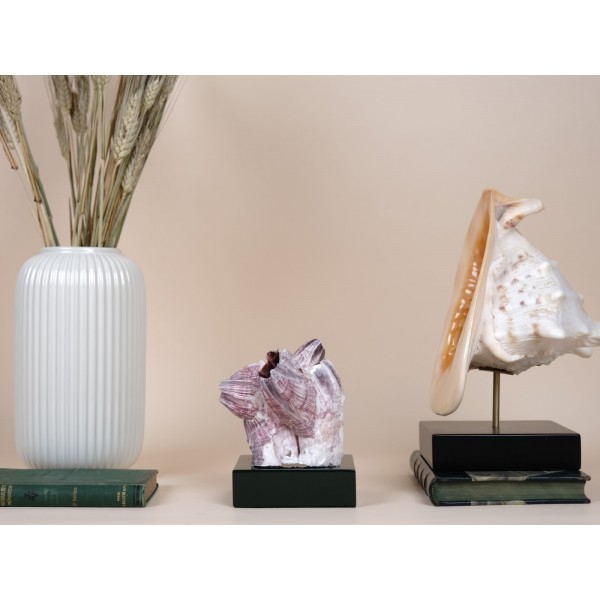Nautilus pompilius illuminated led
Three pairs of beautiful cutted and polished Nautilus pompilius in a new glass vitrine with dark grey lacquered wood base and a high tech led illumination system.
Unique decor piece, designed by One of a Kind.
| close |
This shop uses cookies to improve your experience on our website. |
Reference: N878
Megabalanus tintinnabulum, from Philippines, in a green high gloss wood base.
Megabalanus colonies can reach big size groups, they live attached to rocks and dead coral in watched areas, sometimes attached in boats.
That is the reason why this species can be found in all Indo-Pacific but also in some areas of South Atlantic. Due to the incredible forms and colors they make excellent bizarre decor items.
Dimensions: 14 cm x 12 cm // Base: 10 cm x 10 cm x 3 cm
Weight: 423 g

Megabalanus tintinnabulum, from Philippines, in a green high gloss wood base.
Megabalanus colonies can reach big size groups, they live attached to rocks and dead coral in watched areas, sometimes attached in boats.
That is the reason why this species can be found in all Indo-Pacific but also in some areas of South Atlantic. Due to the incredible forms and colors they make excellent bizarre decor items.
Three pairs of beautiful cutted and polished Nautilus pompilius in a new glass vitrine with dark grey lacquered wood base and a high tech led illumination system.
Unique decor piece, designed by One of a Kind.
Alfonso Sea urchin and White Knobbly Sea urchins tower in brown granite base.
From Madagascar, a different decor piece!
Fantastic deep water Sponge species. A deep water hard sponge, very peculiar resemble Turbinaria coral.
Mounted in a black lacquered wood base, from Tulear, Madagascar waters.
Nine Gorgonocephalus specimen showing several variations displayed in a glass vitrine with black lacquered wooden base.
Gorgonocephalus - Astrospartus mediterraneus is a fantastic deep sea starfish.
These ones have been taken from a deep of 90 meters of Capo Vado, Savona Italy. It is necessary a special technique to dry and to keep it in a perfect shape, turning it a highly decorative and curious species. Sometimes they are attached to sponges and deep water corals.
This species habits until deeps of 800-900 meters.
An outstanding unique dramatic piece, handmade by One of a Kind.
The two valves of a giant Acesta philippinarum, very rare, perfect condition in a pair of black lacquered wood pedestals.
These came from deep water, in tangle nets - from Balicasag island, Philippines.
Five Fusinus colus specimen and nine white sea stars in a glass vitrine with marine blue lacquered wood base, designed by One of a Kind, from Philippines.
A great decor piece!
Sponge species from Madagascar reefs, mounted in a Tecula wood base.
Sponges are beautiful decor items, due to its different shapes and colours.
A beautiful Shell ball made with Strombidae shells, from Indonesia.
These balls are part of the Indo-Pacific cultural heritage, and from a long time tribal people use them as adornment pieces. Today they are natural and beautiful decor pieces.
This stunning Victorian-style table tray features two large valves of Pecten subnodosus, a species of scallop commonly known as the Giant Lion's Paw. Native to the Pacific and Gulf of California coasts of the Baja California Peninsula, Mexico, extending southward to the western coast of Peru. These specimens originate from Baja California, USA. This species is edible.
Mounted in a Victorian style with one Carnelian cabochon and four Amethyst cabochons, all set in a nickel plated base.
Melo umbilicatus - Melon shell in a brass base, from Arafura Sea. Indonesia.
This species belong to the Volutidae family, generelly big sized shells. Can reach near 45 cm, gargantuam specimen usually are very scared and few pattern. This specimen is a medium size one but is beautifully patterned.
Giant Baler - Melo amphora (Lightfoot, 1786) from Australia, in a black lacquered wood base.
Outstanding specimen, with great quality (F+/ F++), hard to find in this size!
Marine Life glass dome with a Yellow hardhead sponge from Florida - USA, a big Scottish Sea urchin from North Sea - UK, Metalia sternalis from Mactan Islands - Philippines, Bolma girgyllus from Palawan Islands. - Philippines and Pocillopora eydouxi from Solomon Islands.
Beautiful colorful decor piece.
Syrinx aruanius - Australian Trumpet shell in a dark brass base.
It's a species of extremely large sea snail measuring up to 91 cm long and weighing up to 18 kg. Shells over 50 cm are now impossible to obtain, specially in good condition. It is a marine gastropod mollusk in the family Turbinellidae, and is the only species in the genus Syrinx.
Superb pair of Hexaplex cichoreus from Balicasag, Philippines.
This intricated species is very variable in pattern and color, along the years we have had exceptional pieces, these ones are of great beauty.
Mounted in a black lacquered wood base.
A curious and very asthetical piece, dyplayed in a small glass dome. Probably the Spondylus grew attached to the back of the Murex shell, From Philippines
Pair of Ovula ovum in white lacquered wood base.
A beautiful pure white pair of Ovula ovum dived in Punta Engaño - Philippines. This shell species is from centuries ago as special and many tribes use them as personal adornments.